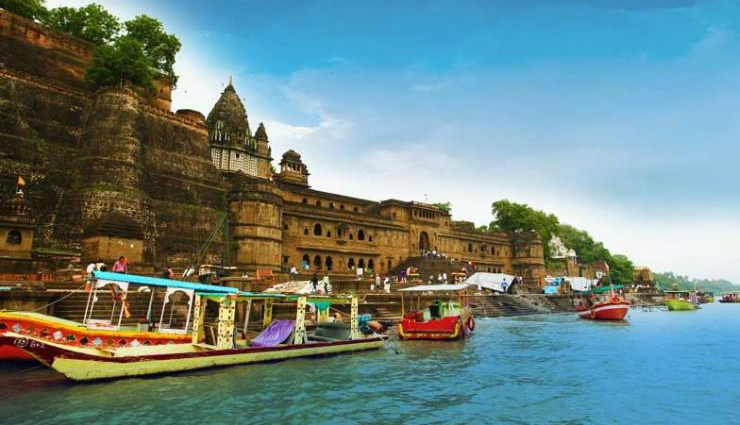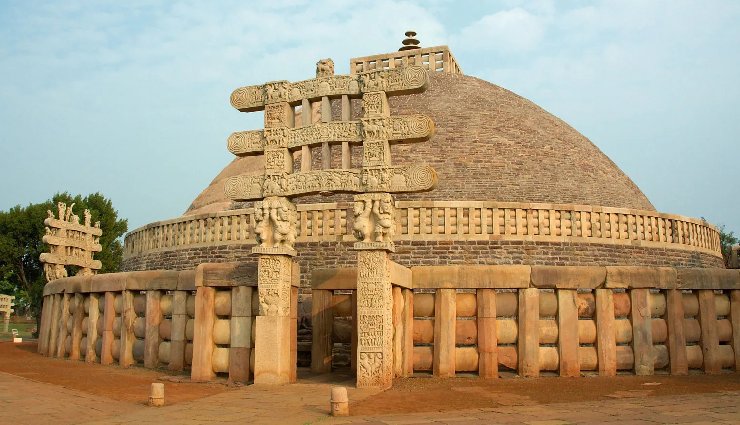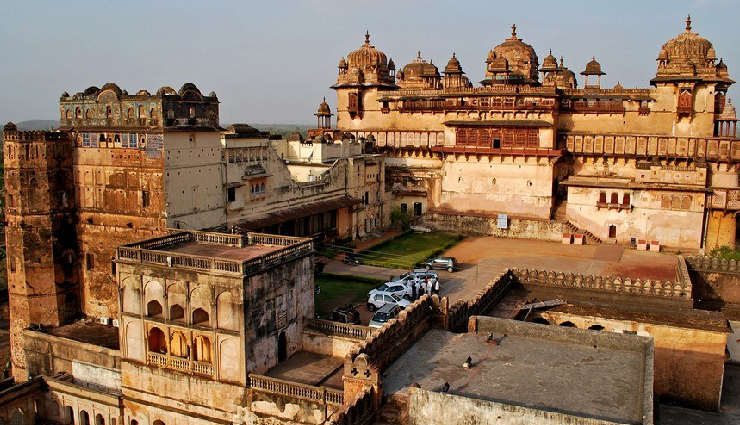10 Must Visit Historical Monuments Of Madhya Pradesh
By: Priyanka Maheshwari Sat, 21 Dec 2024 1:23:05

Madhya Pradesh, often called the heart of India, is steeped in history and culture, offering a treasure trove of remarkable historical sites. From the intricate sculptures of Khajuraho to the ancient Buddhist relics at Sanchi, the architectural wonders of Gwalior Fort, and the peaceful rock shelters of Bhimbetka, these landmarks provide a glimpse into India's rich past.
Each monument, with its distinctive history and artistic charm, highlights the state's historical importance and enduring cultural heritage.

# Khajuraho Group of Monuments
The Khajuraho Group of Monuments, a UNESCO World Heritage Site, is a stunning collection of Hindu and Jain temples in Madhya Pradesh, India. Built by the Chandela dynasty between 950 and 1050 AD, these temples are celebrated for their nagara-style architecture and erotic sculptures. The carvings depict various facets of life, including spirituality, music, and dance, alongside intricate erotic art.
These sculptures present a unique fusion of the physical and spiritual realms, offering a profound insight into ancient Indian culture. The temples are divided into three complexes — Western, Eastern, and Southern — with the Western complex housing the magnificent Kandariya Mahadeva Temple.

# Sanchi Stupa
Sanchi Stupa, a revered UNESCO World Heritage Site in Madhya Pradesh, stands as a monumental symbol of Buddhist heritage and Emperor Ashoka’s legacy. Built in the 3rd century BCE, this revered stupa is famous for its detailed carvings, which narrate significant moments from Buddha’s life, transforming stone into vivid stories.
More than just an architectural masterpiece, the stupa embodies the core principles of Buddhism — enlightenment, tranquility, and harmony. Its four ornate gateways, adorned with exquisite carvings, are a brilliant example of early Buddhist art and architecture. Sanchi attracts thousands of visitors, who come to explore its carvings and immerse in its serene spiritual atmosphere.

# Gwalior Fort
Gwalior Fort, often called the ‘pearl in the necklace of the forts of Hind’, stands proudly atop a rocky hill in Gwalior, Madhya Pradesh. The fort’s history spans over a thousand years, witnessing the rise and fall of various dynasties and rulers. Known for its robust strategic design, impressive palaces, temples, and water tanks, Gwalior Fort is an architectural marvel.
Its walls are adorned with blue ceramic tiles and various inscriptions and carvings. The fort houses notable attractions, including the Man Mandir Palace, the Gujari Mahal (now a museum), and significant temples such as the Teli Ka Mandir and the Saas-Bahu Temple.

# Orchha Fort Complex
The Orchha Fort Complex, located in Orchha, is a testament to the grandeur of the Bundela dynasty. The complex includes several notable structures, such as the Raj Mahal, Jahangir Mahal, and Rai Praveen Mahal. The Raj Mahal is renowned for its stunning murals and frescoes depicting religious and secular themes.
Jahangir Mahal, built to commemorate Emperor Jahangir’s visit, is an excellent blend of Mughal and Rajput architecture. Rai Praveen Mahal, dedicated to the poetess-musician Rai Praveen, is adorned with beautiful gardens. The fort complex, overlooking the Betwa River, offers a picturesque and historically rich experience.

# Bhimbetka Rock Shelters
The Bhimbetka Rock Shelters, located near Bhopal and recognized as a UNESCO World Heritage Site, offer a glimpse into prehistoric India. These ancient shelters boast a remarkable collection of rock paintings, some dating back over 30,000 years, providing invaluable insights into early human civilization and artistic expression.
The paintings depict animals, early hunting scenes, and group activities, offering a window into the daily life of prehistoric communities. The simplicity yet expressiveness of the drawings, created using natural red and white pigments, make Bhimbetka an intriguing site for historians, archaeologists, and tourists alike.

# Udayagiri Caves
The Udayagiri Caves, near Vidisha, consist of twenty rock-cut caves dating back to the early 5th century AD. These caves are significant for their Hindu iconography and inscriptions. Dedicated to gods such as Vishnu, Shiva, and Durga, the caves include one of the earliest depictions of Vishnu in his boar incarnation, Varaha.
The Udayagiri Caves not only represent an extraordinary artistic achievement but also offer valuable insights into the religious and cultural history of the Gupta period, considered the Golden Age of India.

# Mandu
Mandu, or Mandavgad, is a historically significant city in Madhya Pradesh, known for its Afghan architectural influence and romantic legends. Situated in the Vindhya Ranges, Mandu was once the monsoon retreat for the Mughal emperors.
The city is dotted with palaces, Jain temples, and mosques, with notable structures such as Jahaz Mahal, Hindola Mahal, and Jami Masjid. Jahaz Mahal, situated between two lakes, resembles a ship and is an architectural marvel. Mandu is also famous for its Baobab trees, believed to have been brought from Africa over 3000 years ago.

# Rani Roopmati’s Pavilion
Rani Roopmati’s Pavilion, nestled within the Mandu Fort complex, is a romantic symbol of the love story between Rani Roopmati and Baz Bahadur. Perched on a hilltop, it offers breathtaking views of the Narmada River and the surrounding valley. The pavilion blends Indian and Afghan architectural styles and was originally built as a strategic military outpost.
Over time, it became associated with the romantic tale of the poet-princess Roopmati and Sultan Baz Bahadur, adding a layer of romance to its historical significance.

# Bhojeshwar Temple
The Bhojeshwar Temple in Bhojpur, an awe-inspiring yet unfinished structure, is dedicated to Lord Shiva. Built in the 11th century by King Bhoja of the Parmara dynasty, this temple is a masterpiece of medieval Indian architecture. Its grand shikhara, though incomplete, commands respect for its vision and scale.
The temple houses one of India’s largest monolithic lingams, showcasing the extraordinary craftsmanship of the era. Its architectural grandeur and historical importance provide a fascinating glimpse into ancient Indian culture and architectural brilliance.

# Bagh Caves
The Bagh Caves, a group of nine rock-cut Buddhist caves in Madhya Pradesh’s Bagh town, are a prime example of ancient Indian art. Dating from the 4th to 6th centuries AD, these caves, carved into sandstone cliffs, are renowned for their murals, which echo the artistic style of the famed Ajanta Caves.
Despite the passage of time that has faded many frescoes, the remaining paintings and carvings offer invaluable insight into the Gupta period’s art and culture. The Bagh Caves stand as a pivotal site for exploring the development of Buddhist art and architecture in ancient India.
Related Stories:
# 10 Places You Can Visit in Himachal Pradesh in January 2025
# 10 Places You Can Visit Nagahole





